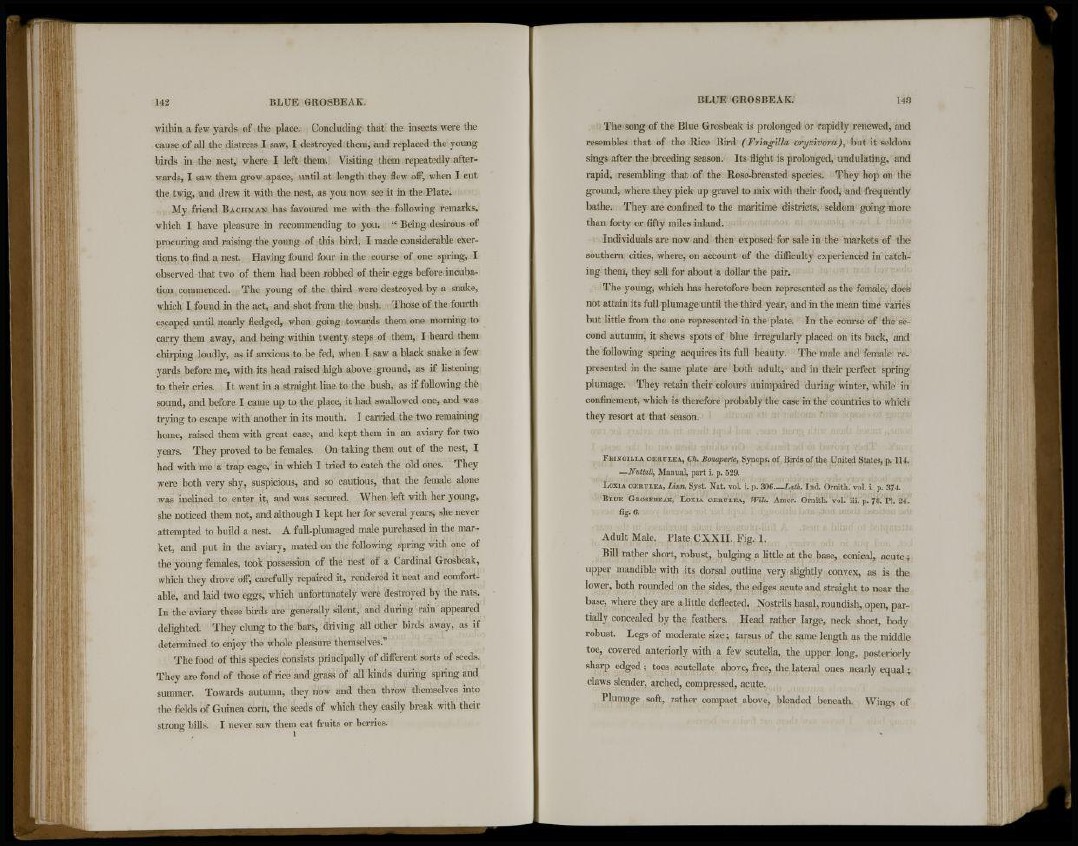
within a few yards of the place. Concluding that the insects were the
cause of all the distress I saw, I destroyed them, and replaced the young
birds in the nest, where I left them. Visiting them repeatedly afterwards,
I saw them grow apace, until at length they flew off, when I cut
the twig, and drew it with the nest, as you now see it in the Plate.
My friend BACHMAN has favoured me with the following remarks,
which I have pleasure in recommending to you. " Being desirous of
procuring and raising the young of this bird, I made considerable exertions
to find a nest. Having found four in the course of one spring, I
observed that two of them had been robbed of their eggs before incubation
commenced. The young of the third were destroyed by a snake,
which I found in the act, and shot from the bush. Those of the fourth
escaped until nearly fledged, when going towards them one morning to
carry them away, and being within twenty steps of them, I heard them
chirping loudly, as if anxious to be fed, when T saw a black snake a few
yards before me, with its head raised high above ground, as if listening
to their cries. It went in a straight line to the bush, as if following the
sound, and before I came up to the place, it had swallowed one, and was
trying to escape with another in its mouth. I carried the two remaining
home, raised them with great ease, and kept them in an aviary for two
years. They proved to be females. On taking them out of the nest, I
had with me a trap cage, in which I tried to catch the old ones. They
were both very shy, suspicious, and so cautious, that the female alone
was inclined to enter it, and was secured. When left with her young,
she noticed them not, and although I kept her for several years, she never
attempted to build a nest. A full-plumaged male purchased in the market,
and put in the aviary, mated on the following spring with one of
the young females, took possession of the nest of a Cardinal Grosbeak,
which they drove off, carefully repaired it, rendered it neat and comfortable,
and laid two eggs, which unfortunately were destroyed by the rats.
In the aviary these birds are generally silent, and during rain appeared
delighted. They clung to the bars, driving all other birds away, as if
determined to enjoy the whole pleasure themselves.'"
The food of this species consists principally of different sorts of seeds.
They are fond of those of rice and grass of all kinds during spring and
summer. Towards autumn, they now and then throw themselves into
the fields of Guinea corn, the seeds of which they easily break with their
strong bills. I never saw them eat fruits or berries.
The song of the Blue Grosbeak is prolonged or rapidly renewed, and
resembles that of the Rice Bird (Fringilla oryzivora), but it seldom
sings after the breeding season. Its flight is prolonged, undulating, and
rapid, resembling that of the Rose-breasted species. They hop on the
ground, where they pick up gravel to mix with their food, and frequently
bathe. They are confined to the maritime districts, seldom going more
than forty or fifty miles inland.
Individuals are now and then exposed for sale in the markets of the
southern cities, where, on account of the difficulty experienced in catching
them, they sell for about a dollar the pair.
The young, which has heretofore been represented as the female, does
not attain its full plumage until the third year, and in the mean time varies
but little from the one represented in the plate. In the course of the second
autumn, it shews spots of blue irregularly placed on its back, and
the following spring acquires its full beauty. The male and female represented
in the same plate are both adult, and in their perfect spring
plumage. They retain their colours unimpaired during winter, while in
confinement, which is therefore probably the case in the countries to which
they resort at that season.
F R I N G I L L A COZRULEA, Ch, Bonaparte, Synops. of Birds of the United States, p. 114.
—Nuttall, Manual, part i. p. 529.
L O X I A CCERULEA, Linn, Syst. Nat. vol. i. p. 3 0 0 Lath. Ind. Ornith. vol. i. p. 374.
B L U E G R O S E B E A K , L O X I A C U - R U L E A , Wils. Amer. Ornith. vol. ill. p. 78. PI. 24.
fig. 6.
Adult Male. Plate CXXII. Fie. 1.
Bill rather short, robust, bulging a little at the base, conical, acute ;
upper mandible with its dorsal outline very slightly convex, as is the
lower, both rounded on the sides, the edges acute and straight to near the
base, where they are a little deflected. Nostrils basal, roundish, open, partially
concealed by the feathers. Head rather large, neck short, body
robust. Legs of moderate size; tarsus of the same length as the middle
toe, covered anteriorly with a few scutella, the upper long, posteriorly
sharp edged; toes scutellate above, free, the lateral ones nearly equal ;
claws slender, arched, compressed, acute.
Plumage soft, rather compact above, blended beneath. Wings of